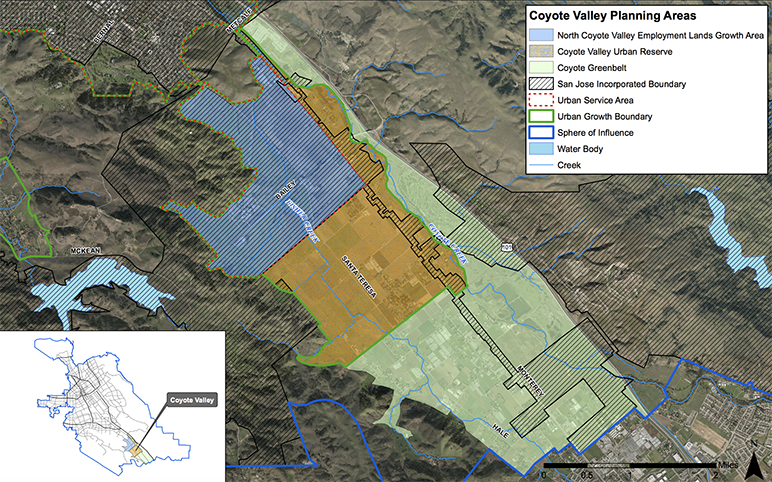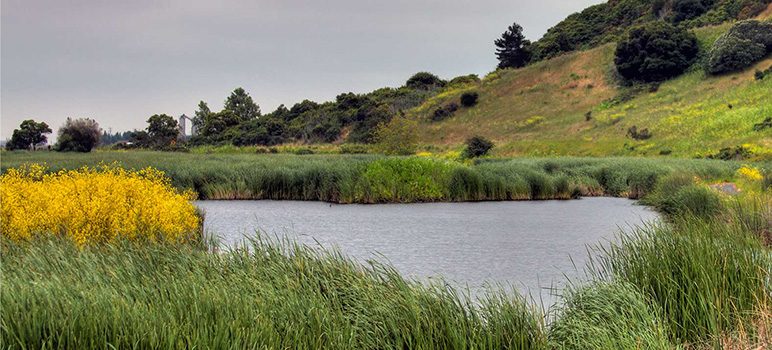Voters overwhelmingly passed Measure T in November, allocating $650 million for emergency preparedness and public infrastructure. That price tag—by far the largest voter-approved bond in the city’s history—also included up to $50 million for land conservation largely in the Coyote Valley.
On Tuesday, the San Jose City Council will discuss Measure T-related conservation plans for Coyote Valley, which is one of the largest remaining expanses of wild land in the Bay Area and the only connection between the Santa Cruz Mountains and the Diablo range. The 7,400-acre valley floor is home to endangered wildlife as well as more than 200 species of birds and safe drinking water.
The discussion is part of a multi-week process to determine whether Coyote Valley will remain untouched, or if commercial development should be allowed on the site.
Several projects over the past four decades have come close to encroaching on Coyote Valley, but—aside from a research facility and a golf course—nothing particularly substantial has been built over the wildlife habitat. Apple founder Steve Jobs considered Coyote Valley as a potential site for his company’s HQ, but ultimately decided against it. Hundreds more firms followed his lead when the Dot Com bubble burst, leaving many companies in the area to consolidate.
Council members this week will consider 60 pages worth of public input concerning development in Coyote Valley, including a memo from the California Legislature, a 25-page environmental study by the Santa Clara Valley Open Space Authority, a letter from former President Obama Interior Secretary Sally Jewell and scores of residents who oppose business development in the valley.
“The investment of Measure T money will help protest what natural infrastructure we still have remaining,”reads the letter signed by five state lawmakers, including Assembly members Ash Kalra (D-San Jose) and Kansen Chu (D-San Jose) and state Sen. Jim Beall (D-San Jose). “We applaud the city of San Jose for making a bold decision to help expand the preservation of Coyote Valley, protect it from further development and use opportunities like those offered through Measure T to permanently preserve this remarkable place for people, wildlife and our environment.”
Hopkins & Carley, one of Silicon Valley’s most prominent law firms, wrote in support of development, contending that building in the area would create something on the order of 35,000 jobs. “Environmental advocates do not have to provide services to the residents and taxpayers of San Jose” read the letter by Hopkins & Carley lawyer and former San Jose Mayor Chuck Reed. “Nor do they have to balance their interests with the interests of the entire City. We can protect Coyote Valley without destroying its jobs capacity.”
The Open Space Authority study maintains that conserving Coyote Valley would increase the city’s clean water supply, continue absorbing flood waters from reaching San Jose and provide a preserve trail for residents to hike through.
WHAT: City Council meets
WHEN: 1:30pm Tuesday
WHERE: City Hall, 200 E. Santa Clara St., San Jose
INFO: City Clerk, 408.535.1260; Click here to read the agenda

Source: City of San Jose Planning Department


Red Alert, Endangered species act Violation.
Anyone even thinking about developing the Coyote Valley zone shall be immediately deported to Northern New Jersey and enrolled in a Secaucus mud flat until they are dissolved !
It’s the Law……………..
The only bond measures I ever vote Yes on are the ones that are used to fund open space preservation.
Coyote Valley is worth preserving especially when you consider that the alternative is to let our politicians ply their destructive ways and extend San Jose’s slum and blight inducing “affordable housing” mandates to these 7,000 acres.
> The only bond measures I ever vote Yes on are the ones that are used to fund open space preservation.
Galtus:
Splain sumpin.
How are “open spaces” used?
I know that the Mt Umunhum Open Space has been closed off to the public and used by illegal marijuana growers.
I have heard of other cases where open space insiders arranged for land adjacent to their homes to be incorporated into “open space”, thus creating a huge, never-to-be-developed back yard for their property AND increasing their home values significantly.
So, why “open space”?
Who REALLY benefits?
Yes, I was the subject of warning shots from those pot growers on a couple of occasions. But finally Mt. Um is open to the public and there’s some pretty good new trails up there .
But in general it seems to me that there’s a whole lot more special interests pressuring for development than there are advocating to limit it. So I’m encouraged when our politicians for once are acting in, or at least appear to be acting in the public interest. Just think of the hundreds of property owners with parcels of 5 to 20 acres and how much they would cash in if their land was rezoned to allow 20 houses on that land instead of just one. That can amount to irresistible lobbying pressure and the sooner the temptation is taken away from our brilliant politicians to succumb to it the better for we the people.
And how do I get down off this high horse anyway?
Welfare for the rich. Nothing new under the sun in the Bay Area.
Chuckles Reed is for it. Enough said.
If you won’t let them develop their own property then you must pay them for the privilege of not doing anything with it.
What would we do if the Indians owned it?